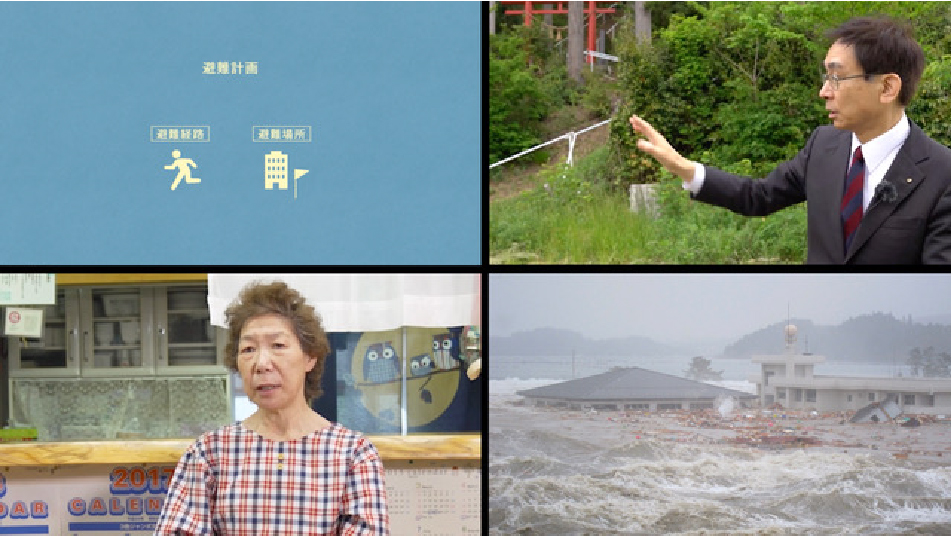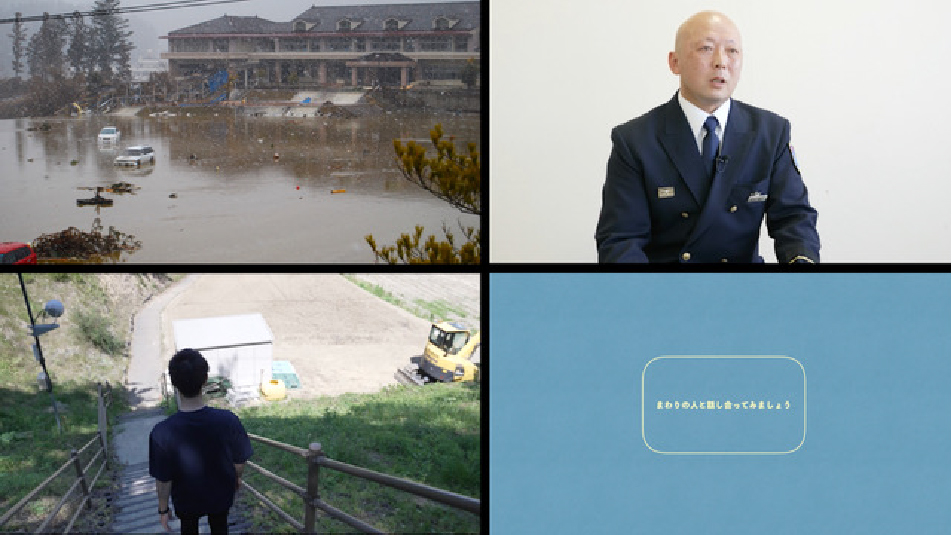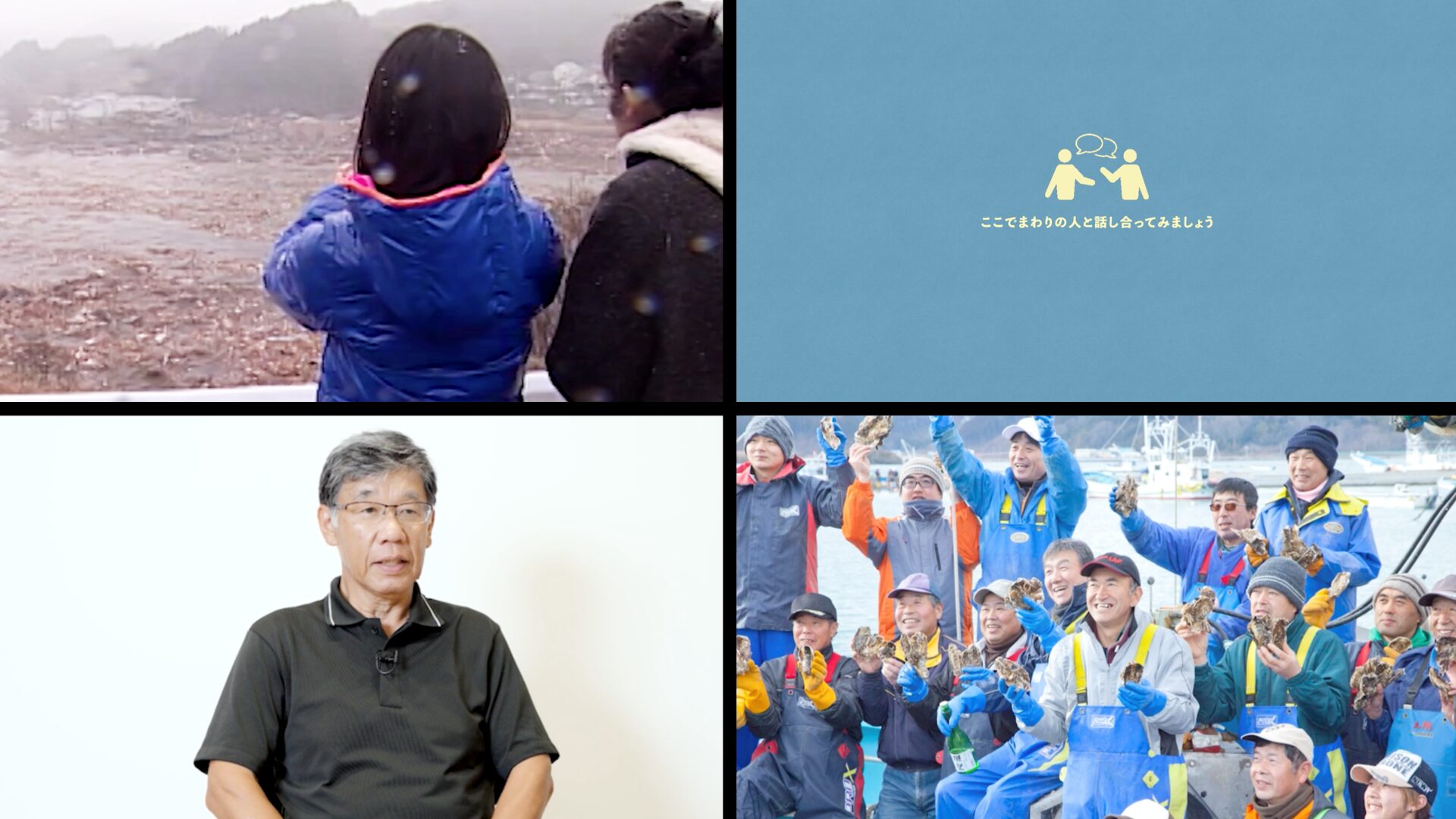Learning Programs
ラーニングプログラム
On that day, faced with a natural threat completely beyond human understanding, how did the people of Minamisanriku act? If you had been in their shoes, how would you have made decisions and taken action?
Please check the availability of your desired date and time, and register below.
In the Learning Program, you will think about natural disasters from your own perspective. It is the main content of the MINAMISANRIKU 311 Memorial.
You will watch the firsthand accounts of town residents, think about what you would have done in the same situations, and discuss your thoughts with the people around you.

Voices of Customers Who Experienced the Learning Program
-
PROGRAM 1
An Evacuation That Became Matter of Life or Death

Regular Program
Minamisanriku has suffered from repeated damage by tsunamis. In preparation for future tsunamis, the residents of Minamisanriku held regular community-wide evacuation drills based on predetermined disaster-prevention plans. Despite these efforts, however, many people lost their lives in the tsunami that far exceeded our estimation. The program will bring you new understandings and discoveries from the accounts of residents who were faced with life-and-death situations on that day, about the actions people took, as well as how they spent that frigid night when all communication with the outside world was cut off, along with discussions with other participants about the ultimate preparation that can be made to protect lives in natural disasters.Venue : Learning TheaterDuration : About 60 minutes, including the time to see the paid exhibition area*This program will be conducted with the Disaster Prevention Mini-Book, which will be distributed to participants. Please bring the mini-book back home with you for everyday disaster-prevention practice at home.
*Short programs, which are excerpts of the Regular Program for smaller topics, with a duration of about 30 minutes (including the time to see the paid exhibition area).For visitors who are short on time, we recommend checking the screening times of the short programs before your visit.chapter 1 " Evacuation;Life and Death ""Evacuate to higher ground" or "evacuate to the rooftop"? What were the two years of debate among teachers regarding the evacuation plan for elementary schools and the decisions made on March 11? We ponder what we should do to protect lives.chapter 2 " Protecting the Lives of Survivors "In the darkness of the conference room on the 5th floor of the public Shizugawa Hospital, and atop the rooftop chilled by the freezing cold of a funeral parlor, residents endured nights repeatedly besieged by tsunamis. Who provided encouragement to people in such extreme conditions? We contemplate what can be done amidst adversity.chapter 3 " Townspeople Helping Each Other "When the disaster struck, inland residents immediately initiated relief efforts. Amidst the disruption of lifelines, we ponder why such swift action was possible. -
PROGRAM 2
When the Time Comes, Will You Be Able to Protect Your Life?

Regular Program
During the Great East Japan Earthquake, many municipally designated evacuation sites were struck by the tsunami. When a natural disaster such as a tsunami occurs, you may be faced with situations you have never imagined before. Simply following evacuation plans and drills may not be enough to ensure survival. On that day, residents encountered unexpected situations where they were forced to make life-and-death decisions. From their firsthand accounts, you will learn that keeping yourselves safe is not as straightforward as it might seem in our minds. Through dialogue with the others, the program will invite you to seek the essence of what it means to save lives from a natural disaster, thinking in terms of your own community and environment.Venue : Learning TheaterDuration : About 60 minutes, including the time to see the paid exhibition area*This program will be conducted with the Disaster Prevention Mini-Book, which will be distributed to participants. Please bring the mini-book back home with you for everyday disaster-prevention practice at home.
*Short programs, which are excerpts of the Regular Program for smaller topics, with a duration of about 30 minutes (including the time to see the paid exhibition area).For visitors who are short on time, we recommend checking the screening times of the short programs before your visit.chapter 1 " Protecting Life "Natural disasters bring about unexpected circumstances. On that day when a tsunami struck the hilltop middle school designated as an evacuation site, what were the thoughts and actions of the students? We reflect on what we should always keep in mind to respond to unforeseen situations.chapter 2 " All the Hard Training Was for That Day "Why were local residents and middle school students able to rescue the firefighter who drifted at sea for over three hours? Should we venture into danger to rescue others? We discuss and contemplate about preparations to protect lives. -
PROGRAM 3
Reflecting on Life
 Since losing so much in the natural disaster, the people of Minamisanriku have been thinking deeply about “life”. This new program reminds us that thinking about life creates strength for tomorrow and the power of renewal. We learn that the sense of security of being in a shelter with others can sometimes dull our sense of danger. Through the testimonies of elementary school students and fishermen from that time, we listen to how they lived their lives after the disaster. By learning about the sadness of losing loved ones and the process of rising up from the depths of disappointment, we are made to think about what we should cherish in our daily lives, not only in times of disaster, but also in our daily lives.Venue : Learning TheaterDuration : About 60 minutes, including the time to see the paid exhibition area
Since losing so much in the natural disaster, the people of Minamisanriku have been thinking deeply about “life”. This new program reminds us that thinking about life creates strength for tomorrow and the power of renewal. We learn that the sense of security of being in a shelter with others can sometimes dull our sense of danger. Through the testimonies of elementary school students and fishermen from that time, we listen to how they lived their lives after the disaster. By learning about the sadness of losing loved ones and the process of rising up from the depths of disappointment, we are made to think about what we should cherish in our daily lives, not only in times of disaster, but also in our daily lives.Venue : Learning TheaterDuration : About 60 minutes, including the time to see the paid exhibition area*This program will be conducted with the Disaster Prevention Mini-Book, which will be distributed to participants. Please bring the mini-book back home with you for everyday disaster-prevention practice at home.
